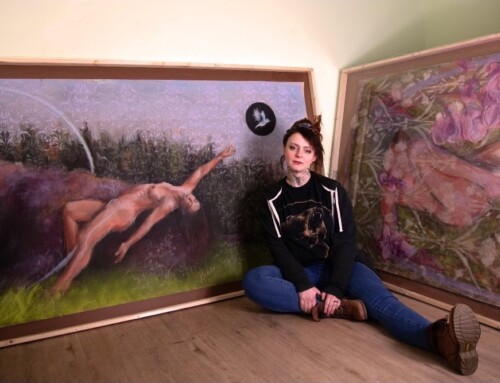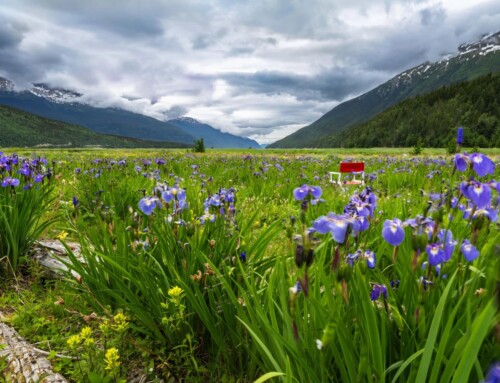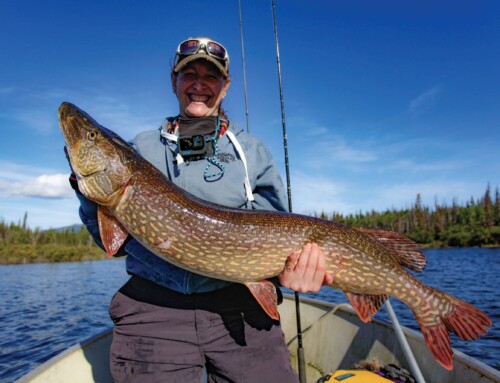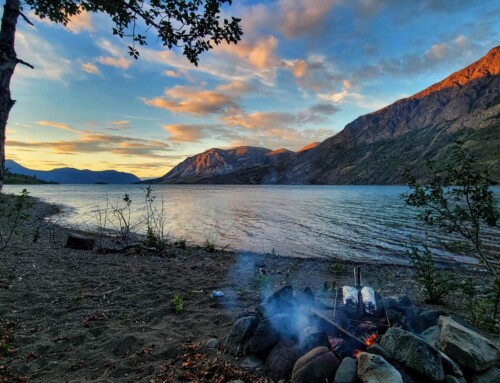By ANDREW CREMATA
The withered wooden structure seemed to take form amidst the quivering aspen leaves and the twisting branches that formed them. It was an old wooden tramway pylon; one in a series leading up the mountainside, all connected by a coiled-steel cable glazed with burgundy rust. A few steps away, a tattered mining car still clung to a limp section of the thick metal wire, slowly being swallowed by purple lupines and wild yellow daisies. A crowned sparrow landed on the cable and trilled in my direction.
A little more than a hundred years ago, this Yukon tramway hummed with activity. It was used to convey rock and ore down Montana Mountain to Conrad City on the Windy Arm of Tagish Lake, where a sternwheeler would carry away the precious cargo in its creaking wooden hull.
The mines were worked by men equipped only with pick axes and candles, and they would fill the gravity-fed tramway with large rocks so that the silver, quartz, and gold could make its way down the steep slope through a forest of spruce and pine.
The scattered remnants of that ill-fated enterprise litter the landscape. Some are hand-hewed structures toppling under the weight of time. There are also the tramway pylons, the cable, and random weathered cans and broken furnaces, some of which seem to be sinking beneath the plane of the earth’s crust.
I was hiking the vertical ascent of the Sam McGee Trail, created by the famed Yukon road-builder for the purpose of servicing the tramway during its short operative lifetime. While Sam McGee was busy forging this path through the trees and underbrush, Robert Service was busy sorting through a list of account holders at the Bank of Commerce in Whitehorse. Service was searching for a name to attach to a new poem he was writing about the cremation of one particularly cold prospector, and it had to rhyme with “Tennessee.”
This was the birth of a northern legend, although the cremation of Sam McGee was grossly exaggerated. Mcgee returned to the Yukon in 1938, and was amused to find tourists buying his “genuine” ashes as souvenirs from wily northern entrepreneurs.
Now we’ve come full circle, and the Yukon is once again bustling with progress in the form of invigorated tourism and cleverly marketed outdoor adventure. I’ve noticed this trend over the last few years, and it’s one of the reasons I like to fish early in the morning – well before the hum of tour buses fills the air and random hoards of weekend warriors attack the lake in search of trout, exercise, or a healthy buzz.
An unrelenting wind had forestalled my fishing plans, and if you’ve ever cast a line into such a wind, then you truly understand futility. You can launch the lure with all of your force and it will briefly zip toward its target before being captured by the current of air, hurtling it wildly into whatever direction the breeze may be blowing. If you’re casting into a headwind, this is not a good thing. I know this because, sadly, I’ve tried.
Fortunately, the Yukon is all wide open spaces, ripe for exploration. And so, I decided to walk along Sam McGee’s trail. From an exposed ridge near the top of the path, I could see tramway pylons spaced evenly down the mountainside toward the lakeshore, and I tried to imagine this wilderness fully inhabited by humans in the summer of 1905. During that year, Conrad City was the most thriving community in the Yukon, and Colonel John Conrad was its king.
Wanderings of foot often lead to wanderings of the mind, and my thoughts of the past led to more about the future. Specifically, a question posed to me by a fishing partner on a recent trip.
“Where do you see this place in another 100 years?” they asked.
That’s a good question, and certainly open to conjecture, but much like peering over that cliff and imagining the landscape formerly teeming with people, the future I envision is also full of two-legged inhabitants.
When you combine development with our ever-increasing temperatures, more visitors are inevitable. This may be a mixed blessing, depending on your point of view, but from the viewpoint of a fisherman who likes the quiet and solitude of wide open spaces, it’s a difficult prospect to reconcile.
Wherever humans gather en masse, they leave behind a noticeable wake. Since the days when Conrad City became nothing more than a historic curiosity, it has been a place of respite for Yukoners and Skagwegians. Primitive campsites make for a less-than-ideal bathroom situation, but it’s arguably one of the most beautiful places on the planet.
The recent surge of tourism around Carcross motivated the Yukon government to funnel taxpayer dollars through the narrow corridor of Windy Arm to create an improved campsite at Conrad. This is progress, and only time will tell if the changes can truly be called “improvements.”
To envision the future, you need only examine the past. If you’re 60 or more years old then you were born closer to the Gold Rush than to today. A century of mans’ progress gave us penicillin, spaceflight, and fingertip access to the sum of all human knowledge. That same progress has left heaps of broken bottles, piles of plastic, and the occasional unidentifiable piece of rubbish. At least you can take solace in the fact that it only takes 100 years for litter to be considered an artifact.
More people often means less fish, and that’s the thought that keeps creeping into my mind. Especially when looking out into the great expanse of the Yukon River’s headwaters. Upon that precipice I see a coming transition, as the last of the Gold Rush’s relics seem to crumble a little more with each passing day.
Like the banks of Bonanza Creek, bleeding with gold beneath its swelling waters in the spring of 1899, the shores of Windy Arm will certainly teem with more RVs, more adventure-seekers, more tourists. It’s possible that the names of our region’s most famous historical figures will succumb to the weight of time – the monikers of Skookum Jim and Soapy Smith replaced by those of the characters on the most popular television reality shows.
This is the product being sold as modern Alaska: Weirdos eking out a false living in some mythical wilderness that doesn’t even exist. A reality dictated by entertainment, where history must conform to a narrative that bolsters the bottom line on a stockholder’s annual report.
Here lies the Yukon in transition – a place where more and more people will travel, and in their quest to find something “real,” everything authentic will become unhinged from its origins. This marks the moment when life becomes a simulation of itself, where the quest for experience trumps the desire to make sense of the past and our own place within the present.
Later that day, the wind subsided and I was able to fish for a few hours without a bite. I didn’t see another person as I worked a lonely, meandering shoreline north of Conrad City – something that may not be possible for very much longer.
Considering our region’s storied history, you never know what the future may bring.






Leave A Comment